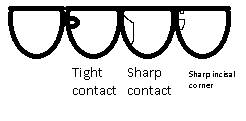Placing anterior matrix strips
In the past I have had difficulties in placing the clear mylar strips in class 3 cavities where there is a strong or a sharp contact as in the picture below.
-Tight contacts tend to bunch up the matrix and when you eventually jam it down it has a poor contour
-Sharp contact will do the same, where there is a thin bit or supported incisal edge and it will catch or dent the matrix
-Sharp incisal corner i.e if there is a small chip just off the location of the incisal corner. This may be in composite veneer cases where you want a clear strip to separate the teeth or in class 3 cases in a bruxer. I have found the matrix may want to go into this little divot rather than sliding between the teeth
Solutions are currently:
-Take a bur or polishing disc and cut off the obstruction. This is destructive especially for the tight contact case where there is a fair bit of supporting tooth structure
-Use a tofflemire matrix or other metal matrix. This is more rigid and can be forced between the contact without distorting. It may be more difficult to adapt the composite to, difficult to cure and you can't see the composite before the final cure. It will also be more difficult to make a good contact as the material is thicker. This is most useful in the tight contact and sharp incisal corner situation as there is already a contact present. In the sharp contact case a significant portion of the interproximal will have an open contact which can be problematic for aesthetics
-Approach the interproximal space from the embrasure on the labial or lingual. This is best for the sharp contact case, take your mylar strip and push it into the contact from the labial or lingual rather than from the incisal.
I have not tried the bioclear matrices from ivoclar but they do appear stiffer and may be useful in these case as well.

-Tight contacts tend to bunch up the matrix and when you eventually jam it down it has a poor contour
-Sharp contact will do the same, where there is a thin bit or supported incisal edge and it will catch or dent the matrix
-Sharp incisal corner i.e if there is a small chip just off the location of the incisal corner. This may be in composite veneer cases where you want a clear strip to separate the teeth or in class 3 cases in a bruxer. I have found the matrix may want to go into this little divot rather than sliding between the teeth
Solutions are currently:
-Take a bur or polishing disc and cut off the obstruction. This is destructive especially for the tight contact case where there is a fair bit of supporting tooth structure
-Use a tofflemire matrix or other metal matrix. This is more rigid and can be forced between the contact without distorting. It may be more difficult to adapt the composite to, difficult to cure and you can't see the composite before the final cure. It will also be more difficult to make a good contact as the material is thicker. This is most useful in the tight contact and sharp incisal corner situation as there is already a contact present. In the sharp contact case a significant portion of the interproximal will have an open contact which can be problematic for aesthetics
-Approach the interproximal space from the embrasure on the labial or lingual. This is best for the sharp contact case, take your mylar strip and push it into the contact from the labial or lingual rather than from the incisal.
I have not tried the bioclear matrices from ivoclar but they do appear stiffer and may be useful in these case as well.

Comments
Post a Comment
Please leave a comment and let me know what you think or if there are any topics you would like covered in the future